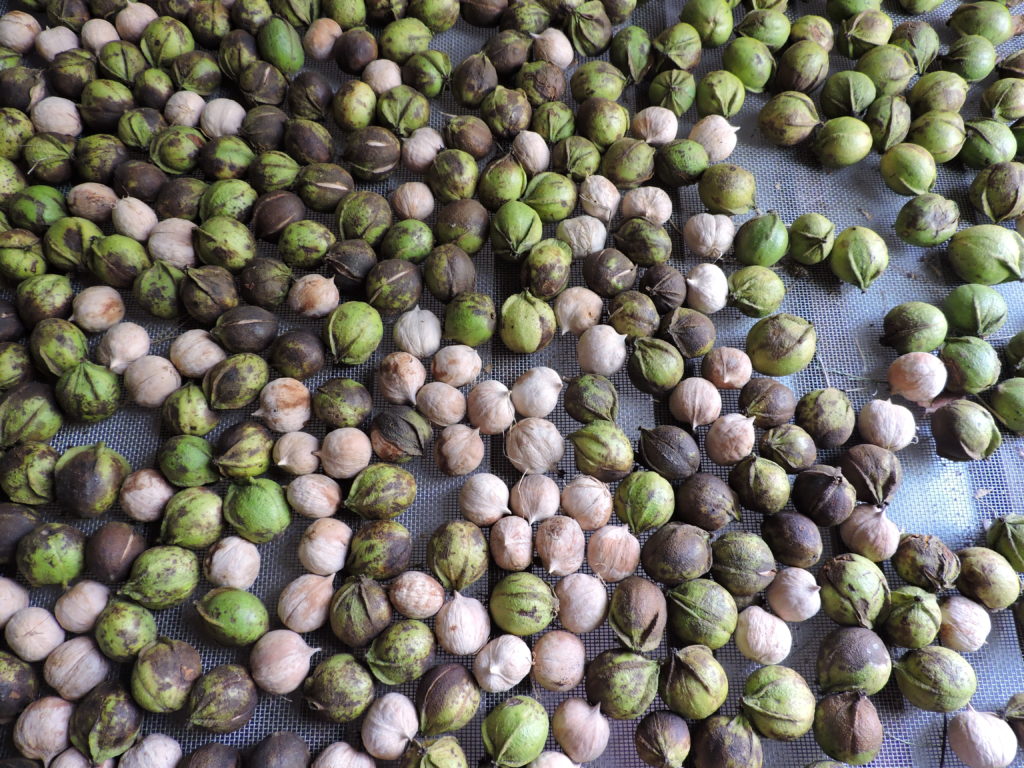I totally geeked out and compared a variety of 3 month storage methods for a variety of nuts other than acorns. (Acorns are addressed HERE.) A little lingo to get us on the same page…
HUSKS: Husks are the outermost layer of the nut, sometimes spiny (chestnuts) sometime wooden (mockernut hickory), sometimes thin like skin (bitternut hickory). When storing nuts of any kind, if you can easily remove the husks before storage, you should do so as it will save space and reduce the moisture content and thus reduce molding.
HULLS: Hulls are the usually hard shell material that comes in direct contact with the nutmeats. Hulls often need cracking.
| SUMMARY OF TEST STORAGE BEST RESULTS: Buckeye: Freezing. (I have not done room temperature tests.) Butternut: In husk, air dry, single layer, indoors at room temperature. Chestnut, Chinese: Refrigerate in mesh bag or breathable plastic clamshell container. Soak nuts in hulls (spiny husks removed) submerged in water for a minimum of 4 hours at least once prior to storage. Hickory, Bitternut: In husk, air dry, single layer, indoors at room temperature. Hickory, Mockernut: Husk removed, air dry, indoors at room temperature. Walnut, Black: In husk, air dry, single layer, indoors at room temperature. |
Buckeyes
*THE WINNER–BEST RESULT for 3 month storage= Freezing is my current recommendation, but I have not yet done the room temperature tests.
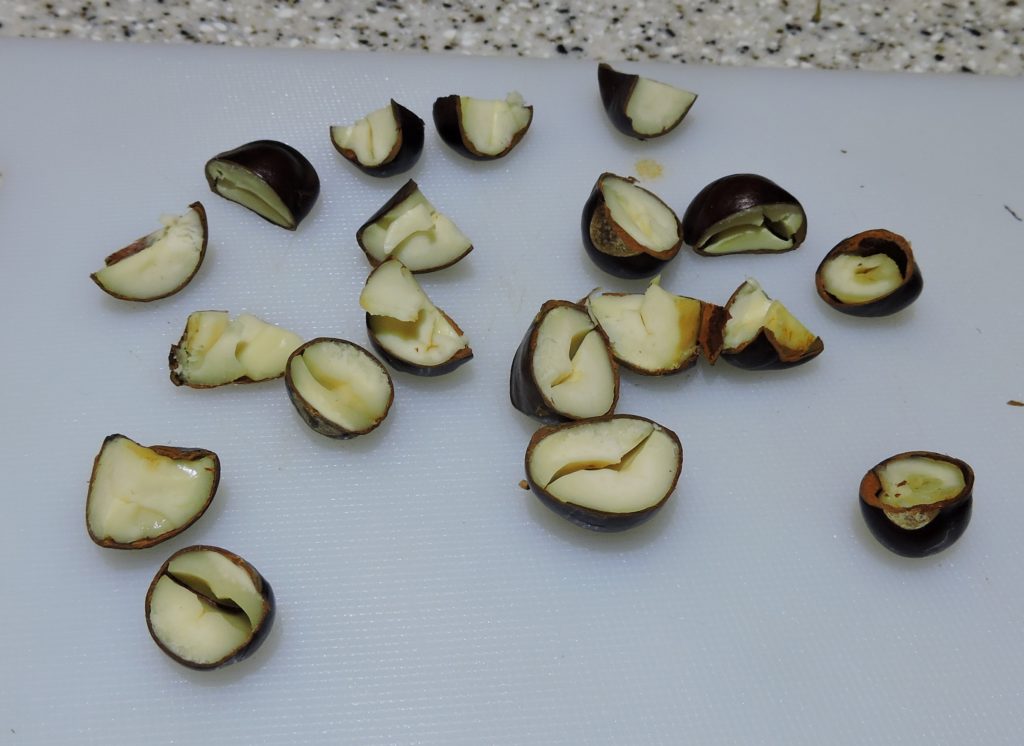
- Room Temperature Indoors, in Open Air Test after Baking for 1 Hour at 175 degrees Have not yet done this test.
- Room Temperature Indoors, in a Closed Ziplock Bag Test Have not yet done this test.
- Refrigerator Test: I stored buckeyes in husks starting late September in a breathable mesh bag on the top shelf of the refrigerator for 3 months. Soaked buckeyes for 8 hours in water at the beginning. Then re-soaked 6 hours at 1 month in and re-soaked again for 45 minutes at 2 months in. Cut them open for assessment at 3 months. Results were that he buckeyes were completely dried out, the husks so hard I could not cut them with a knife and had to instead smash them with a hammer. The nutmeat was not at all moldy but was rock hard. Maybe a squirrel would still gnaw on them?
- Freezer Test: I stored buckeyes in husks starting late September in a rigid plastic lidded container (Tupperware-like) for 3 months, then thawed and cut them open for assessment. Results were that all 5 test samples were usable, but quality was reduced after thawing. The thawed nutmeats were slightly softer and when pressed, a small amount of moisture beaded up on the surface. Quality was diminished, but okay. If you had a large buckeye supply and you could not use them all, freezing a portion would give you some backup.
Butternut
*THE WINNER–BEST RESULT for 3 month storage= In husk, air dry, single layer, indoors at room temperature. I have not done any other tests because I don’t have access to enough butternuts to try, but the 3 nuts I kept for 3 months in husks inside at room temperature were perfect when I cracked them open at the New Years.
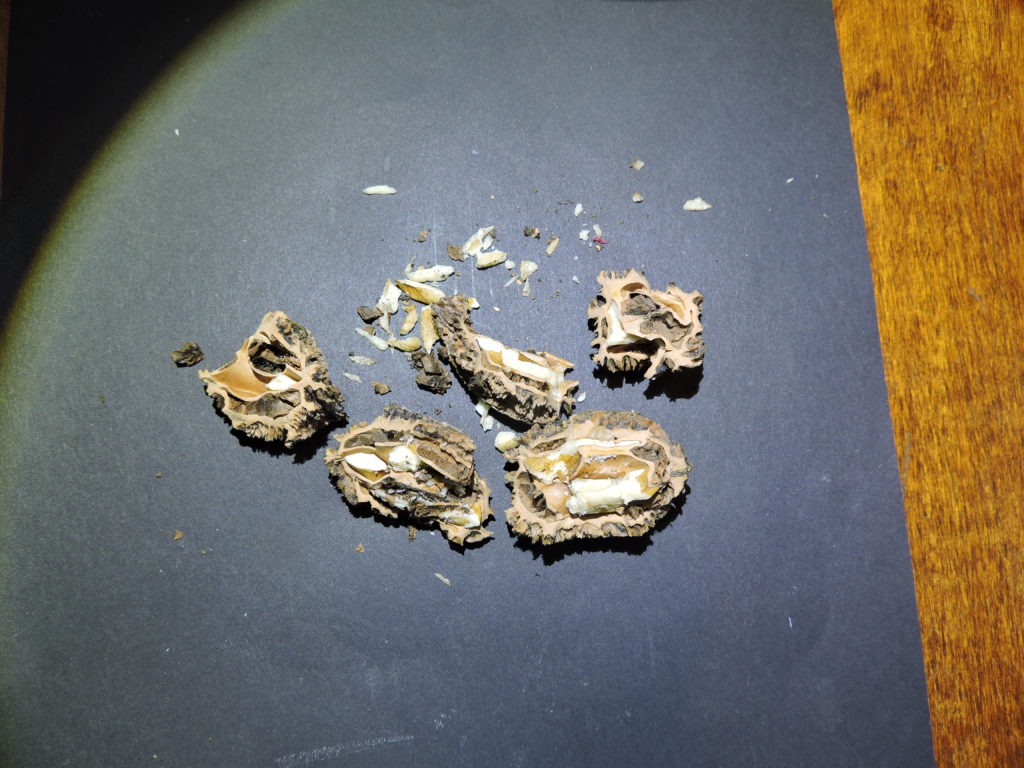
Chestnut, Chinese
*THE WINNER–BEST RESULT for 3 month storage= Refrigerate in mesh bag or breathable plastic clamshell container. For now I will still say to soak nuts in hulls (spiny husks removed) submerged in water for a minimum of 4 hours at least once prior to storage. I might drop the soaking recommendation after further testing.
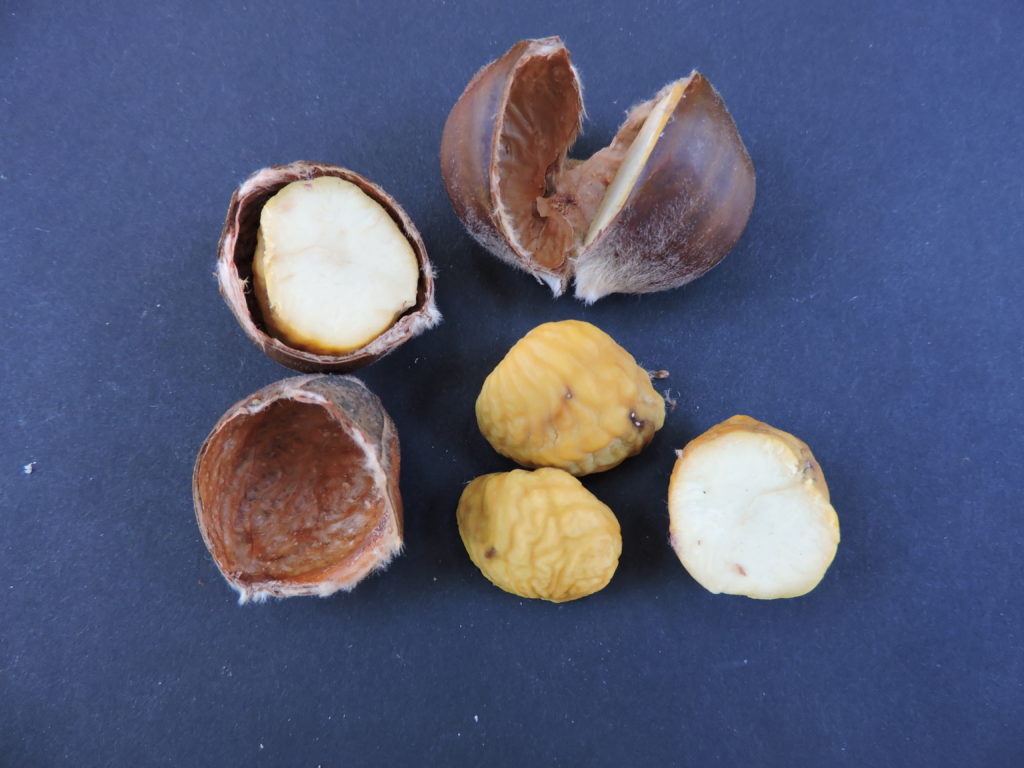
- Room Temperature Indoors, in Open Air Test Have not yet done this test.
- Refrigerator, in Mesh Bag Test: I stored chestnuts (spiny husk removed) starting late September in a breathable mesh bag on the top shelf of the refrigerator for 3 months. I soaked the chestnuts for 8 hours in water at the beginning. Then re-soaked 6 hours at 1 month in and re-soaked again for 45 minutes at 2 months in. Cut them open for assessment at 3 months. Results were that the chestnuts were in very good shape, as good as “new” or maybe even better because they had cured a few months. In the future, I may do a test without any re-hydrating soaks to see if chestnuts even need that. I could see no discernable visual difference in the nuts inside or outside at all.
- Freezer, in Plastic Lidded Container Test: I stored chestnuts (spiny husk removed) starting late September in a rigid plastic lidded container (Tupperware-like) for 3 months, then thawed and cut them open for assessment. Results were that all 5 test samples were usable, but quality was reduced after thawing. The thawed nutmeats were slightly softer and when pressed, a small amount of moisture beaded up on the surface. Quality was diminished, but okay. If you had a large chestnut supply and you could not use them all, freezing a portion would give you some backup.
Hickory, Bitternut
*THE WINNER–BEST RESULT for 3 month storage= In husk, air dry, single layer, indoors at room temperature.
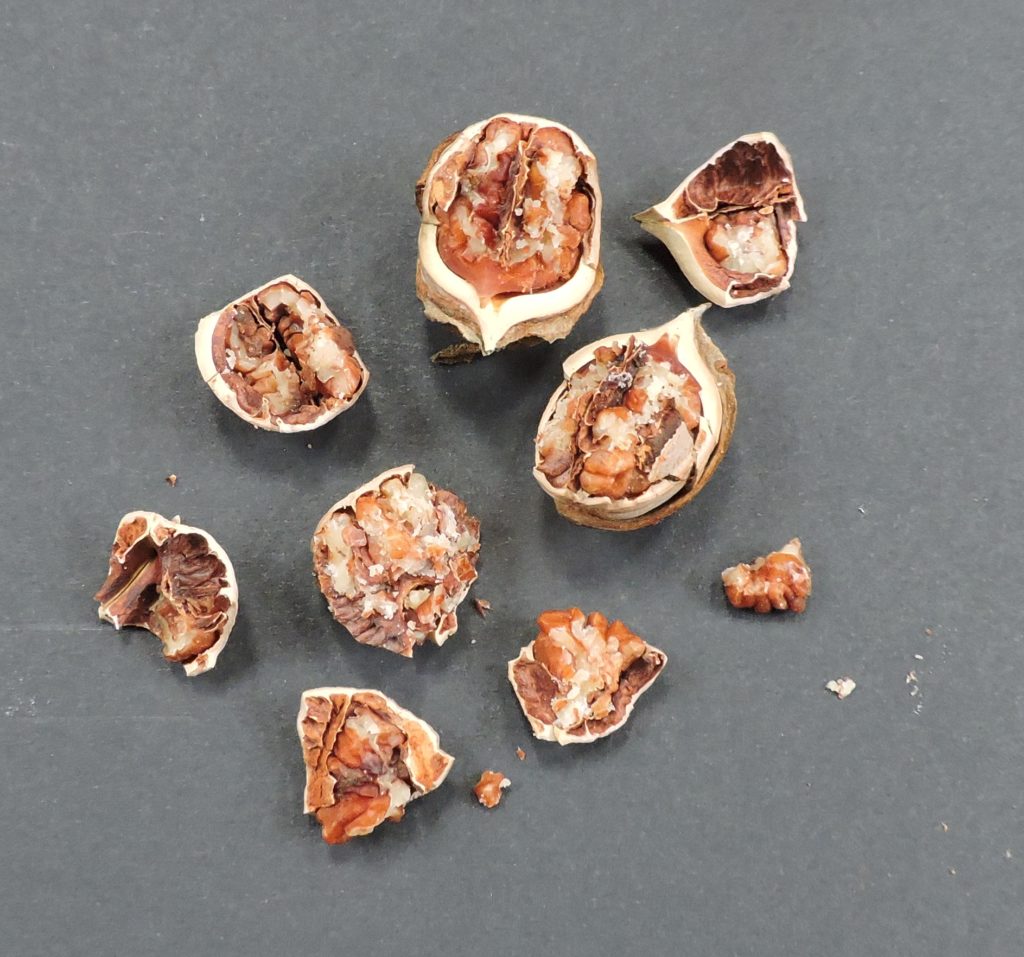
- Room Temperature Indoors, in Husk, in Open Air Test After 3 months, all three of these samples were in very good shape and tasted about the same as when first collected.
- Room Temperature Indoors, in Husk, in Open Air Test after Baking for 1 Hour at 175 degrees.Interestingly, all 3 nuts that were baked in husks before open air storage were moldy when broken open 3 months later.
- Room Temperature Indoors, in Husk, in a Closed Ziplock Bag Test Total fail, all 3 nuts had their husks on them when collected. The husk could not be easily removed from the shell, so it was left on, and the nuts placed in a zip lock bag at room temperature. Three months later all 3 nuts were visibly covered with mold outside and were liquefied and gooey inside.
- Refrigerator, in Husk, in Mesh Bag Test: I stored bitternuts in a breathable mesh bag on the top shelf of the refrigerator for 3 months. The husk darkened and dried and was easy to peel off 3 months later. the nutmeat inside the cracked shell was of good quality.
- Freezer, in Husk, in Plastic Lidded Container Test: I stored bitternuts in a rigid plastic lidded container (Tupperware-like) for 3 months, then thawed and cracked them open for assessment. All were okay, but the nutmeat was a little softer and spongier—usable but diminished quality.
Hickory, Mockernut
*THE WINNER–BEST RESULT for 3 month storage= Husk removed, air dry, indoors at room temperature.
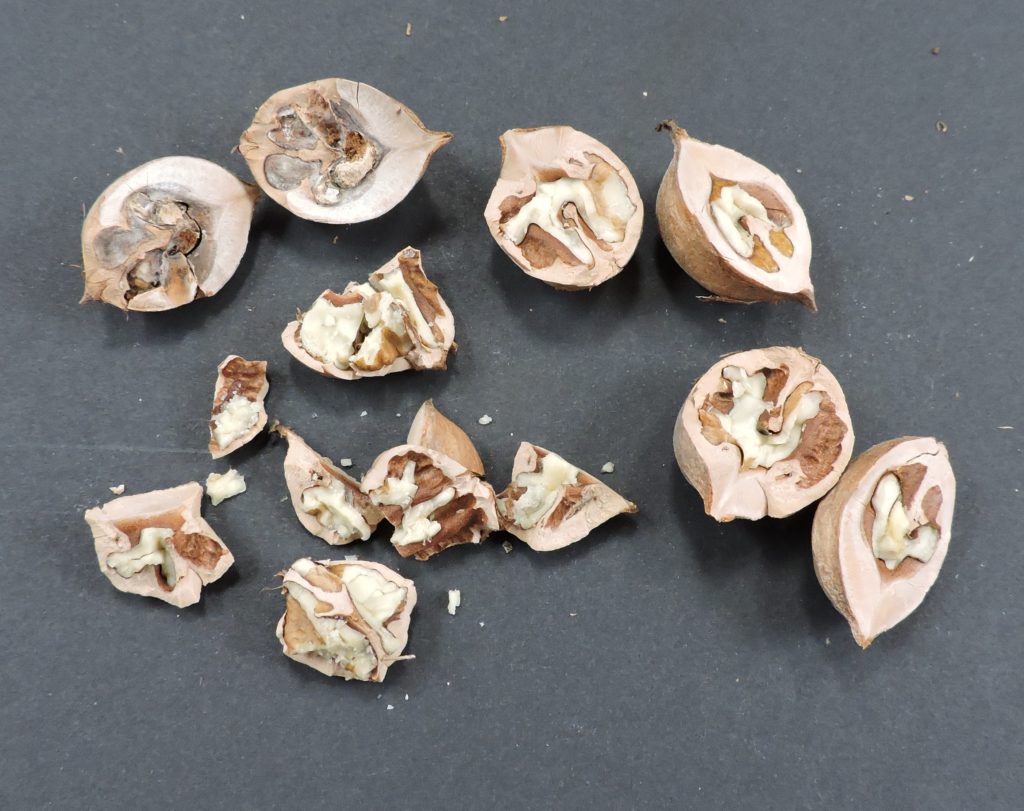
- Room Temperature Indoors, Husk Removed, in Open Air Test After 3 months, ¾ of these samples were in very good shape and tasted yummy. One nut was moldy inside the cracked nut.
- Room Temperature Indoors, Husk Removed, in Open Air Test after Baking for 1 Hour at 175 degrees.After 3 months, ½ of the nuts were fine and yummy, one was moldy and one was dried up.
- Room Temperature Indoors, Husk Removed, in a Closed Ziplock Bag Test Unlike the bitternut hickories, the mockernuts were not stored with their husks. So, the zip lock bagging did not increase molding in this sample. ¾ of the nuts were fine, but the nutmeats were a little more dried out than the room temperature air-dry sample. One nut was completely dried up and inedible.
- Refrigerator, Husk Removed, in Mesh Bag Test: I stored mockernuts in a breathable mesh bag on the top shelf of the refrigerator for 3 months with no husk on them. 1/3 of nuts were fine, 1/3 had a moldy powder on the nuts inside after cracked, and 1/3 was completely dried and inedible.
- Freezer, Husk Removed, in Plastic Lidded Container Test: I stored mockernuts in a rigid plastic lidded container (Tupperware-like) for 3 months, then thawed and cracked them open for assessment. They all looked perfect prior to cracking open, but 2 were completely dried out, one was moldy and one was fine quality nutmeat, but the nutmeat was a little softer and spongier than non-frozen mockernuts—usable but diminished quality.
Walnut, Black
*THE WINNER–BEST RESULT for 3 month storage: In husk, air dry, single layer, indoors at room temperature.
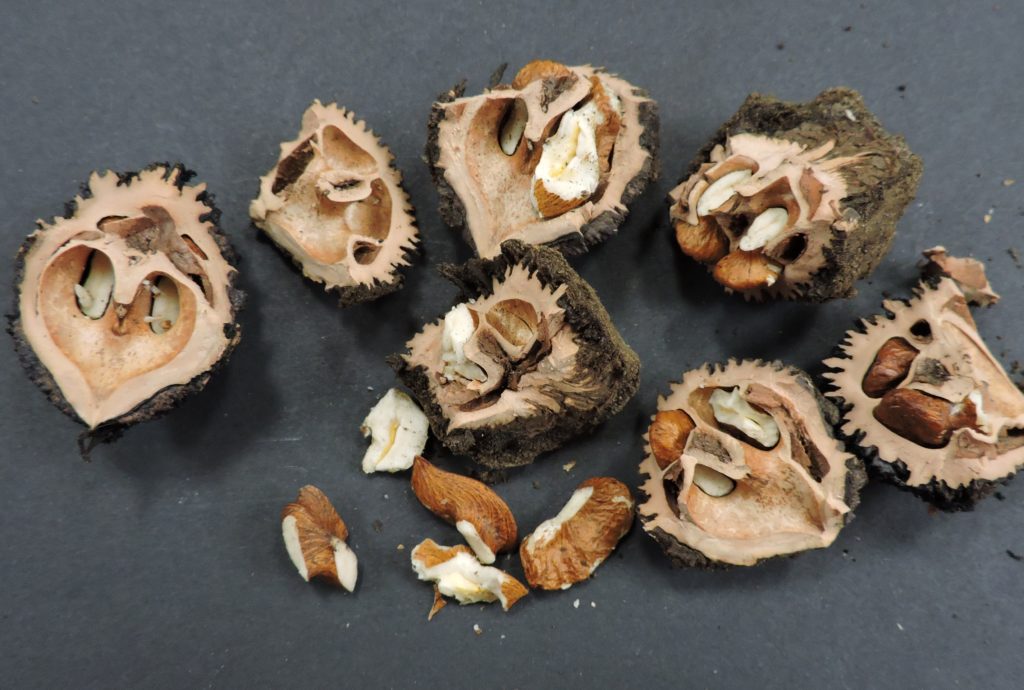
- Room Temperature Indoors, in Open Air Test After 3 months, all three of these samples were in perfect shape and easy to husk and hull.
- . Room Temperature Indoors, in Husk, in Open Air Test after Baking for 1 Hour at 175 degrees. All were fine, but nutmeat was a little drier and tasted a little cooked. Not as good as air dry method by itself.
- Room Temperature Indoors, in Husk, in a Closed Zip Lock Bag Test Total fail, totally wet, mushy and rotted inside and out. Unusable.
- Refrigerator, in Husk, in Mesh Bag Test: 1/3 of the walnuts had some mold on and under husk. But once the husks were removed and the nut hulls broken open, the nutmeats inside were all very good.
- Freezer, in Husk, in Plastic Lidded Container Test: Husk had darkened was spongy and much easier to remove from nut when it thawed. Nut hull was a little easier to crack with a hammer. Nutmeat was slightly less flavorful and a little soggier, but easier to remove from the shell.
